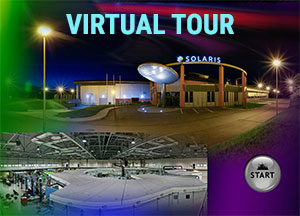 Web Content Display
Web Content Display
SOLARIS centre
 Web Content Display
Web Content Display
 Web Content Display
Web Content Display
Scientific Advisory Committee
SAC members are five outstanding scientists working in prestigious foreign synchrotron centers:
- prof. Nils Mårtensson from Uppsala University - Chairman
- dr Maya Kiskinova from Elettra Synchrotron
- prof. dr Paul Dumas from SOLEIL Synchrotron
- dr Pawel Grochulski from Canadian Light Source
- prof. dr Petra Rudolf from Groningen University.
 Web Content Display
Web Content Display
About the SOLARIS Centre
SOLARIS is a Polish national research centre providing scientists with synchrotron radiation and Cryo-EM.
Synchrotron radiation (also called synchrotron light) is produced in a synchrotron, and then directed to beamlines with experimental end-stations. Beamlines modify the synchrotron light in such a way that it best serves scientists and their measurements. The Centre has been opened for Users since 2018 and at the end of 2021, SOLARIS facilitates the six beamlines, operating in the range of radiation from UV to soft X-ray, providing various experimental techniques. At the PIRX beamline, the Users can exploit X-ray absorption spectroscopy (XANES region, X-ray absorption near edge structure) and magnetic dichroism. The main technique at the URANOS beamline is Angle-resolved photoelectron spectroscopy (ARPES). The PHELIX beamline based on two methods, ARPES and X-ray absorption spectroscopy (XANES). The DEMETER beamline offers two end-stations: Scanning transmission X-ray microscopy (STXM) and Photoemission electron microscopy (PEEM). The bending magnet, opened in 2022 ASTRA beamline is dedicated to X-ray absorption spectroscopy (XAS). Recently opened POLYX beamline is a compact beamline for X-ray microimaging and X-ray microspectroscopy in the energy range 4-15 keV.
Next three new beamlines are under construction - CIRI, SOLCRYS, SMAUG - and they will be open in the next years. Ultimately, however, the experimental hall of the Kraków accelerator will house dozens of them. In total, the beamlines will be fitted with about twenty end-stations. SOLARIS Centre is more than the synchrotron alone. In our building, there are also two cryo-electron microscopes of the latest generation: Titan Krios G3i and Glacios.
Synchrotrons allow us to look into the depths of matter itself, and carry out precise analyses. Thanks to synchrotrons, scientists study not only the composition of a given substance, but also its structure – the light of the synchrotron can penetrate into the studied material. It can reproduce hidden layers or fragments of them with any level of detail, without damaging the surface layers. Synchrotron radiation also stimulates processes taking
place in the material, and can bring about changes in the studied material.
Synchrotrons open up completely new research possibilities. Thanks to them, we can carry out analyses which were previously impossible. Synchrotrons also allow us to obtain better results than those from studies carried out using traditional methods. The synchrotron beamlines are currently the most versatile research tools possessed in the natural and technical sciences, such as biology, chemistry, physics, materials engineering, nanotechnology, medicine, pharmacology, geology, or crystallography.
The SOLARIS Centre is open for all intereted scientists, both from Poland and abroad. Calls for proposals are announced twice during a year (in spring and autumn). Applications must be submitted online, via the Digital User Office website. The international commission decides on the allocation of beamtime. The access to the infrastructure is free of charge.
The National Synchrotron Radiation Centre functions under the auspices of the Jagiellonian University. It is located on the Campus of the 600th Anniversary of the Jagiellonian University Revival, in the southern part of Kraków. It neighbours the Kraków Technology Park special economic zone. The project Centre was established between 2010 and 2015. The investment was co-financed by the European Union with funds from the European Regional Development Fund, as part of the Innovative Economy Operational Programme for 2007-2013.
The excellent parameters of the SOLARIS synchrotron put it in the forefront of this type of devices in the world.

